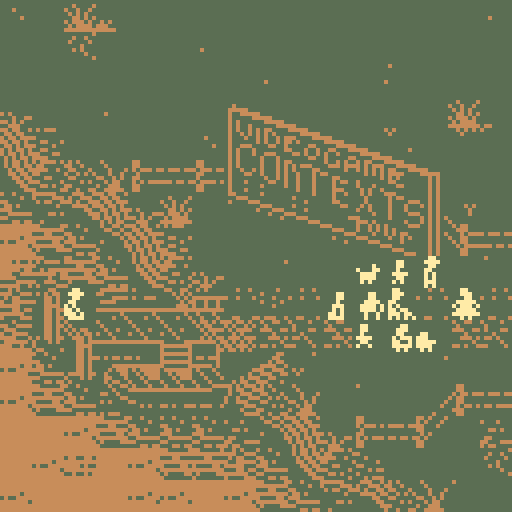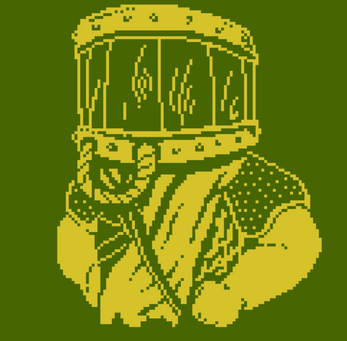The Solivagants (or, Videogames Fail at Character Context)
A playful examination of Character Context; a long-neglected aspect of game design and technological development. It's more fun than it sounds. :)
This was my entry for the Bitsy Essay Jam.
And if you liked this, please check out my other Bitsy game, Cinerarium (of Solaris).
v1.5 UPDATE
- complete rewrite
- new introduction scene
Credits
Game
- Rowan Crawford
Engine
References
Erik Wolpaw, Deus Ex Walkthru, 2000-06-20
Kieron Gillen, New Games Journalism, 2004-03-23
Yahtzee Crowshaw, A Storytelling Crysis, 2013-03-12
Jonathan Morin, Context is Everything, 2010-01-17
Hidetaka Miyazaki, Deracine Q&A, 2018-11-05
Other Research
Adrian Chmielarz, (in article by David Houghton, 2013-11-08)
Chris Nonis, (on the two schools of RPG thought)
Darby McDevitt, Are Game(r)s Art(ists)?, 2013-03-12
Michael Lutz, The Games People Replay, 2014-04-02
Nick Dinicola, The Problem with Emergent Stories in Video Games, 2013-07-30
Terence Lee, Designing game narrative, 2014-04-02
Tadhg Kelly, On Player Characters and Self Expression, 2012-07-06
Tom Francis, The Indie Soapbox Sessions, GDC 2012
Yahtzee Crowshaw, Context, Challenge & Catharsis, 2013-12-17
Yahtzee Crowshaw, Context, Challenge & Gratification, 2011-12-13
| Status | Released |
| Platforms | HTML5 |
| Rating | Rated 5.0 out of 5 stars (29 total ratings) |
| Author | Rowan Crawford |
| Made with | bitsy |
| Tags | 2D, Bitsy, essay, Game Design, Pixel Art |
| Average session | A few seconds |
| Languages | English |
| Inputs | Keyboard, Touchscreen |



Comments
Log in with itch.io to leave a comment.
Played this, and I remembered a pretty bad example I played recently, Scribblenauts. Really it fails on, a lot of context stuff, but purely on character awareness? Well: some puzzles can be solved by unnecessary violence, resulting in scared NPCs overall, only for that scared NPC to then go,"Take my starite shard, hero!" Tied into that, characters can end up in horrific pain basically because you gave them a harmful version of the item they wanted, and you still get rewarded for it by them. There are times when you wanna yell at the game because it feels like the charaecters in the world don't understand that an item you made is an exact replica of the one they wanted, ETC. I honestly could write my own, possibly kind of long, essay about how Scribblenauts is just, an absolute trainwreck of it understanding what the player can do character and story awareness wise, resulting in a game that REWARDS the player for going against the wholesome message of the game,"Help others in need." I'm kind of surprised it wasn't included in some ways because of how bad it is for this stuff.
Love it! The examples were very useful in understanding the themes!
Your curation is lovely! I love that it’s outside and then inside. The inside one reminded me of those volunteer “museums”, where it’s actually just someone’s home and they get funding for their storing and tours.
The loading of interiors and it’s assets always made the two feel like different worlds in games. In my personal life, the inside and outside are much more mixed. Although, I guess I’ve been homeless, dispatched, or travelling for more of my life than I have housed. I might be too small of an audience to design for.
I liked seeing what you chose to highlight. I would love to make my own exhibit one day.
I’d want to juxtapose exhibit from games with huge teams beside exhibits of games with teams of <10. Petting the dog would for sure be in there. Prey’s opening personality test. FF9 where if you choose the same dialogue box wrong to kidnap the queen ~64 times Baku does something, throws the doll? Untitled Goose’s whole premise. There’d be a waterfall in one and behind it would be dialogue about waterfall treasures. And juxtaposing it there’d be a potted plant with a “come back on new years” message and a three-frame animation of the plant blooming and a cryptid insect “pixel bug” is just a pixel and flies to the plant and move on and the plant dies. The fireworks presents! Was that from earthbound?
I hope flags and context trigger tools see much more development! I hate thinking they are what gets considered “creature creep” material, meanwhile debugging meshes gets a whole slice of the game development cake.
Right now, it is a tragedy how much development time it takes to set and debug 1 flag. Let alone 1 after another. Your game fails character context in a silly way I found at the end. When I put my coat back on to leave after the portal was activated, the log said I was indecent wearing my coat around when the host activated the portal specifically for me to leave.
Bye.
Thanks for playing the game. :)
I enjoyed your curatorial list of, I guess, interesting videogame moments and player expectations? (an exhibition should almost always have a unifying theme :)
Nice find on that bug too. Another thing for the todo pile.
Absolutely fantastic!!
Thanks :D
The two-line high textbox + long sentences negatively impacted readability, but it was ok for a bitsy jam essay
Yeah, I see there's a hack available to extend the size of the textbox and I'm working on a post-jam-director's-cut now so I might look into that.
that was funny, informative, pretty, and provoking. really cool lil' interactions as well! and yeah, all videogame essays should be videogames! it makes it easier to pay attention to. wonderful<3
Thanks for checking it out :)
Where is the white ring?
When I go in the house, am I in the basement or is the ring really on the second floor?
When you go in the house you're on the ground floor. The white ring is up on the first floor.
Nice, neat essay and showcase packed with a lot of research! Would be interested to see what other games would go along with the -presumed- new wing of the museum along with Disco Elysium.
I do find it interesting that character context seems to primarily only come about from the game "observing" itself and the player, and the development of that context can only work within the constraints that the game itself has to think about itself (the Skyrim bucket being the most blatant example).
Thanks!
The limits/constraints for what the game itself can see are created by the game developers themselves, so if we're serious about improving character-context then we need to improve in-game tools that allow us to determine things like: what characters can see and have seen, what they would be thinking NOW, and they WERE thinking; and then to organise this information into logical hierarchies so that we can easily pick an action/reaction that makes sense given all that context. At that moment our gaves have no technology for any of that. Meanwhile, graphics tech has progressed to the point that we have dedicated parallel processors capable of producing nearly photorealistic visuals. That's the imbalance I was hoping to highlight here.
And as for other games, here are some that were considered but didn't make the cut:
Positive examples:
- Hades (merged it with Bastion)
- the Dark Souls / Bloodborne games do some interesting things in a particular facet of this idea
- Portal's dialogue is very cleverly reactive to what the player is doing
- Telltale's Walking Dead games appear to do it though on subsequent playthroughs you can see that they're just very cleverly designed as to give the impression
Negative Examples:
- Watch Dogs: Legion
- Tomb Raider
- Assassin's Creed 3
- any game with a waist-high obstacle that you can't jump over or a stack of objects in a corridor that you can't either pull apart or just crawl through but are instead stuck completely unless you find some random route around
Cool !
Danke :D
Oh hey, this is really good and very informative.
Gracias :)
well that was gorgeous AND informative AND nostalgic AND I’m very glad I remembered to get my coat before leaving!
Thanks :D